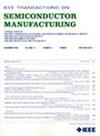基于知识蒸馏网络的高效双注意无监督晶圆图异常检测
IF 2.3
3区 工程技术
Q2 ENGINEERING, ELECTRICAL & ELECTRONIC
引用次数: 0
摘要
检测晶圆图异常对于防止半导体制造中的良率损失至关重要,但复杂的模式和资源密集型标记数据前提条件阻碍了精确的深度学习分割。本文提出了一种创新的无监督方法,用于检测晶圆图中的像素级异常。它利用高效的双重关注模块和知识提炼网络来学习无异常的缺陷分布。除了在教师网络的特征金字塔层次结构上加入高效的双重注意模块外,知识转移是通过将预先训练好的教师网络中的信息提炼到具有类似结构的学生网络中来实现的,这种结构通过捕捉位置和通道维度中的上下文关联,增强了金字塔层次结构中的特征表示和分割,从而有选择性地强调相关特征,摒弃无关特征。此外,它还能使学生网络获得更好的分层特征知识,从而准确识别不同尺度的异常情况。特征金字塔中的不相似性可作为一种判别功能,预测异常的可能性,从而实现高精度的像素级异常检测。因此,我们提出的方法在 WM-811K 和 MixedWM38 数据集上表现出色,AUROC、AUPR、AUPRO 和 F1 分数分别为(99.65%、99.35%)、(97.31%、92.13%)、(90.76%、84.66%),推理速度为 3.204 FPS,显示了其高精度和高效率。本文章由计算机程序翻译,如有差异,请以英文原文为准。
Efficient Dual-Attention-Based Knowledge Distillation Network for Unsupervised Wafer Map Anomaly Detection
Detecting wafer map anomalies is crucial for preventing yield loss in semiconductor fabrication, although intricate patterns and resource-intensive labeled data prerequisites hinder precise deep-learning segmentation. This paper presents an innovative, unsupervised method for detecting pixel-level anomalies in wafer maps. It utilizes an efficient dual attention module with a knowledge distillation network to learn defect distributions without anomalies. Knowledge transfer is achieved by distilling information from a pre-trained teacher into a student network with similar architecture, except an efficient dual attention module is incorporated atop the teacher network’s feature pyramid hierarchies, which enhances feature representation and segmentation across pyramid hierarchies that selectively emphasize relevant and discard irrelevant features by capturing contextual associations in positional and channel dimensions. Furthermore, it enables student networks to acquire an improved knowledge of hierarchical features to identify anomalies across different scales accurately. The dissimilarity in feature pyramids acts as a discriminatory function, predicting the likelihood of an abnormality, resulting in highly accurate pixel-level anomaly detection. Consequently, our proposed method excelled on the WM-811K and MixedWM38 datasets, achieving AUROC, AUPR, AUPRO, and F1-Scores of (99.65%, 99.35%), (97.31%, 92.13%), (90.76%, 84.66%) respectively, alongside an inference speed of 3.204 FPS, showcasing its high precision and efficiency.
求助全文
通过发布文献求助,成功后即可免费获取论文全文。
去求助
来源期刊

IEEE Transactions on Semiconductor Manufacturing
工程技术-工程:电子与电气
CiteScore
5.20
自引率
11.10%
发文量
101
审稿时长
3.3 months
期刊介绍:
The IEEE Transactions on Semiconductor Manufacturing addresses the challenging problems of manufacturing complex microelectronic components, especially very large scale integrated circuits (VLSI). Manufacturing these products requires precision micropatterning, precise control of materials properties, ultraclean work environments, and complex interactions of chemical, physical, electrical and mechanical processes.
 求助内容:
求助内容: 应助结果提醒方式:
应助结果提醒方式:


